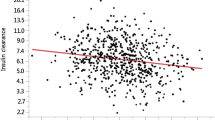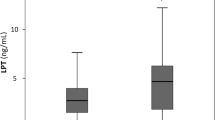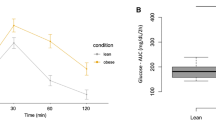Abstract
OBJECTIVE: To evaluate the relation between free testosterone (FT) levels and the intima-media thickness of the common carotid artery (IMT-CCA) in overweight and obese glucose-tolerant (NGT) young adult men.
DESIGN: Cross-sectional study of FT and IMT-CCA in obese men.
SUBJECTS: A total of 127 overweight and obese NGT male individuals, aged 18–45 y.
MEASUREMENTS: FT plasma levels; IMT-CCA, as measured by high-resolution B-mode ultrasound imaging; central fat accumulation, as evaluated by waist circumference; body composition, as measured by bioimpedance analysis; insulin resistance, as calculated by homeostatic model assessment (HOMAIR); systolic and diastolic blood pressure; and fasting concentrations of glucose, insulin, and lipids.
RESULTS: IMT-CCA was positively correlated with age, body mass index (BMI), fat mass (FM), waist circumference, and fasting glucose concentrations, and inversely associated with FT levels. After multivariate analysis, IMT-CCA maintained an independent association with BMI, FM, and FT levels. This study indicates that IMT-CCA is negatively associated with FT levels, independent of age, total body fat, central fat accumulation, and fasting glucose concentrations in overweight and obese NGT patients.
CONCLUSION: Hypotestosteronemia may accelerate the development of atherosclerosis and increase the risk for CHD in obese men.
This is a preview of subscription content, access via your institution
Access options
Subscribe to this journal
Receive 12 print issues and online access
$259.00 per year
only $21.58 per issue
Buy this article
- Purchase on Springer Link
- Instant access to full article PDF
Prices may be subject to local taxes which are calculated during checkout

Similar content being viewed by others
References
De Pergola G . The adipose tissue metabolism: role of testosterone and dehydroepiandrosterone. Int J Obes Relat Metab Disord 2000; 2: S59–S63.
Jockenhovel F, Blum WF, Vogel E, Englaro P, Muller-Wieland D, Reinwein D, Rascher W, Krone W . Testosterone substitution normalizes elevated serum leptin levels in hypogonadal men. J Clin Endocrinol Metab 1997; 82:2510–2513.
De Pergola G, Xu X, Yang SM, Giorgino R, Bjorntorp P . Up-regulation of androgen receptor binding in male rat fat pad adipose precursor cells exposed to testosterone: study in a whole cell assay system. J Steroid Biochem Mol Biol 1990; 37:553–558.
Xu X, De Pergola G, Bjorntorp P . Testosterone increases lipolysis and the number of beta-adrenoceptors in male rat adipocytes. Endocrinology 1991; 128:379–382.
Xu X, De Pergola G, Eriksson PS, Fu L, Carlsson B, Yang S, Eden S, Bjorntorp P . Postreceptor events involved in the up-regulation of beta-adrenergic receptor mediated lipolysis by testosterone in rat white adipocytes. Endocrinology 1993; 132: 1651–1657.
Marin P, Oden B, Bjorntorp P . Assimilation and mobilization of triglycerides in subcutaneous abdominal and femoral adipose tissue in vivo in men: effects of androgens. J Clin Endocrinol Metab 1995; 80: 239–243.
Marin P, Lonn L, Anderrsson B, Oden B, Olbe L, Bengtsson BA, Bjorntorp P . Assimilation of triglycerides in subcutaneous and intraabdominal adipose tissues in vivo in men: effects of testosterone. J Clin Endocrinol Metab 1996; 81:1018–1022.
Phillips GB, Pinkernell BH, Jing Y . The association of hypotestosteronemia with coronary artery disease in men. Arterioscler Thromb 1994; 14:701–706.
Crouse III JR, Craven TE, Hagaman AP, Bond MG . Associations of coronary disease with segment specific intimal-medial thickening of the extracranial carotid artery. Circulation 1995; 92: 1141–1147.
Pignoli P, Tremoli E, Poli A, Oreste P, Paoletti R . Intimal plus medial thickness of the arterial wall: a direct measurement with ultrasound imaging. Circulation 1986; 74:1399–1406.
Salonen JT, Salonen R . Ultrasonographically assessed carotid morphology and the risk of coronary heart disease. Arterioscler Thromb 1991; 11:1245–1249.
Hodis HN, Mack WJ, LaBree L, Selzer RH, Liu C-R, Liu C-H, Azen SP . The role of carotid arterial intima-media thickness in predicting clinical coronary events. Ann Intern Med 1998; 128: 262–269.
O'Leary DH, Polak JF, Kronmal RA, Manolio TA, Burke GL, Wolfson Jr SK . Carotid-artery intima and media thickness as a risk factor for myocardial infarction and stroke in older adults. N Eng J Med 1999; 340:14–22.
Ebrahim S, Papacosta O, Whincup P, Wannamethee G, Walker M, Nicolaides AN, Dhanjil S, Griffin M, Belcaro G, Rumley A, Lowe GD . Carotid plaque, intima media thickness, cardiovascular disease in men and women: The British Regional Heart Study. Stroke 1999; 30: 841–850.
Mack WJ, LaBree L, Liu C-R, Liu C-H, Selzer RH, Hodis HN . Correlations between measures of atherosclerosis change using carotid ultrasonography and coronary angiography. Atherosclerosis 2000; 150:371–379.
Salonen JT, Salonen R . Ultrasound B-mode imaging in observational studies of atherosclerotic progression. Circulation 1993; 87 (Suppl II): 56–65.
Report of the Expert Committee on the Diagnosis and Classification of Diabetes Mellitus. Diabetes Care 1997; 20: 1183–1197.
Matthews DR, Hosker JP, Rudenski AS, Naylor BA, Treacher DF, Turner RC . Homeostatic model assessment: insulin resistance and β-cell function from fasting glucose and insulin concentrations in man. Diabetologia 1985; 28:412–419.
De Pergola G, Giorgino F, Cospite MR, Giagulli VA, Cignarelli M, Ferri G, Giorgino R . Relation between sex hormones and serum lipoprotein and lipoprotein(a) concentrations in premenopausal obese women. Arterioscler Thromb 1993; 13:675–679.
De Mitrio V, De Pergola G, Vettor R, Marino R, Sciaraffia M, Pagano C, Scaraggi FA, Di Lorenzo L, Giorgino R . Plasma plasminogen activator inhibitor-1 (PAI-1) is associated with plasma leptin, irrespective of body mass index, body fat mass, and plasma insulin and metabolic parameters in premenopausal women. Metabolism 1999; 48:960–964.
Heitmann BL . Prediction of body water and fat in adult Danes from measurement of electrical impedance. A validation study. Int J Obes Relat Metab Disord 1990; 14:789–802.
Willeit J, Kiechl S . Prevalence and risk factors of asymptomatic extra-cranial carotid artery atherosclerosis: a population-based study. Arterioscler Thromb 1993; 13:661–668.
Abate N, Haffner SM, Garg A, Peshock RM, Grundy SM . Sex steroid hormones, upper body obesity, and insulin resistance. J Clin Endocrinol Metab 2002; 87:4522–4527.
Levine SA, Likoff WB . The therapeutic value of testosterone propionate in angina pectoris. N Engl J Med 1943; 229:770–772.
Lesser MA . Testosterone propionate therapy in one hundred cases of angina pectoris. J Clin Endocrinol 1946; 6:549–557.
Webb CM, Adamson DL, de Ziegler D, Colins P . Effect of acute testosterone on myocardial ischemia in men with coronary artery disease. Am J Cardiol 1999; 83:437–439.
Jaffe MD . Effect of testosterone cypionate on postexercise ST segment depression. Br Heart J 1977; 39:1217–1222.
Webb CM, McNeill JG, Hayward CS, de Zeigler D, Collins P . Effects of testosterone on coronary vasomotor regulation in men with coronary heart disease. Circulation 1999; 100:1690–1696.
Ong PJL, Patrizi G, Chong WCF, Webb CM, Hayward CS, Collins P . Testosterone enhances flow-mediated brachial artery reactivity in men with coronary artery disease. Am J Cardiol 2000; 85: 269–272.
Kang SM, Jang Y, Kim JY, Chung N, Cho SY, Chae JS, Lee JH . Effect of oral administration of testosterone on brachial arterial vasoreactivity in men with coronary artery disease. Am J Cardiol 2002; 89:862–864.
English KM, Jones RD, Jones TH, Morice AH, Channer KS . Testosterone acts as a coronary vasodilator by a calcium antagonistic action. J Endocrinol Invest 2002; 25:455–458.
Deenadayalu VP, White RE, Stallone JN, Gao X, Garcia AJ . Testosterone relaxes coronary arteries by opening thge large-conductance, calcium-activated potassium channel. Am J Physiol (Heart Circ Physiol) 2001; 281: 1720–1727.
Mukherjee TK, Dinh H, Chaudhuri G, Nathan L . Testosterone attenuates expression of vascular cell adhesion molecule-1 by conversion to estradiol by aromatase in endothelial cells: implications in atherosclerosis. Porc Natl Acad Sci USA 2002; 99: 4055–4060.
Chambless LE, Heiss G, Folsom AR, Rosamond W, Szklo M, Sharrett AR, Clegg LX . Association of coronary heart disease incidence with carotid arterial wall thickness and major risk factors: the Atherosclerosis Risk in Communities (ARIC) Study, 1987–1993. Am J Epidemiol 1997; 146:483–494.
De Pergola G, Ciccone M, Pannacciulli N, Modugno M, Sciaraffia M, Minenna A, Rizzon P, Giorgino R . Lower insulin sensitivity as an independent risk factor for carotid wall thickening in normotensive, non-diabetic, non-smoking normal weight and obese premenopausal women. Int J Obes Relat Metab Disord 2000; 24:825–829.
Ciccone M, Vettor R, Pannacciulli N, Minenna A, Bellacicco M, Rizzon P, Giorgino R, De Pergola G . Plasma leptin is independently associated with the intima-media thickness of the common carotid artery. Int J Obes Relat Metab Disord 2001; 25:805–810.
Author information
Authors and Affiliations
Corresponding author
Rights and permissions
About this article
Cite this article
De Pergola, G., Pannacciulli, N., Ciccone, M. et al. Free testosterone plasma levels are negatively associated with the intima-media thickness of the common carotid artery in overweight and obese glucose-tolerant young adult men. Int J Obes 27, 803–807 (2003). https://doi.org/10.1038/sj.ijo.0802292
Received:
Revised:
Accepted:
Published:
Issue Date:
DOI: https://doi.org/10.1038/sj.ijo.0802292
Keywords
This article is cited by
-
The Interplay between Androgen and Gut Microbiota: Is There a Microbiota-Gut-Testis Axis
Reproductive Sciences (2022)
-
Vascular Pathways of Testosterone: Clinical Implications
Journal of Cardiovascular Translational Research (2020)
-
The relationships between body composition and cardiovascular risk factors in young Australian men
Nutrition Journal (2013)
-
The Significance of Low Testosterone Levels in Obese Men
Current Obesity Reports (2012)
-
The effects of endogenous and exogenous androgens on cardiovascular disease risk factors and progression
Reproductive Biology and Endocrinology (2009)



